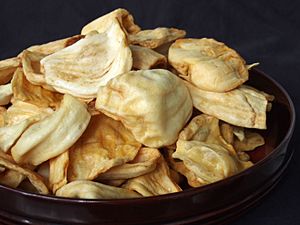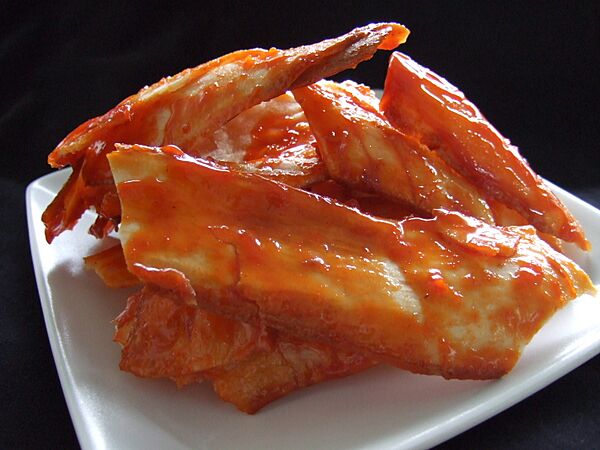Kripik facts for kids

Kripik singkong (cassava) kripik
|
|
| Alternative names | Keripik |
|---|---|
| Course | Snack |
| Place of origin | Indonesia |
| Region or state | Nationwide |
| Serving temperature | Room temperature |
| Main ingredients | Deep fried dried ingredients |
| Variations | Different variations according to ingredients |
Kripik (say "KREE-pick") or keripik are popular snacks from Indonesia. Think of them like crispy chips or crisps. They are usually bite-sized and can be either savory or sweet.
These tasty snacks are made from different dried ingredients. These include fruits, root vegetables (like potatoes), other veggies, and even fish. The ingredients are thinly sliced, dried, and then deep-fried in hot vegetable oil until they are super crispy.
Kripik can be simply seasoned with a little salt. Sometimes, they are spiced up with chili powder and sugar for a sweet and spicy kick. The name kripik is thought to come from the sound these crunchy snacks make when you eat them!
Kripik and krupuk (another type of Indonesian cracker) are a big part of Indonesian cuisine. Kripik are often made from dried slices of roots and tubers. Some of the most famous types are kripik singkong (made from cassava) and kripik pisang (banana chips). You can also find kripik made from many other fruits and vegetables.
Contents
Kripik vs. Krupuk: What's the Difference?
Kripik is very similar to krupuk, but there's a key difference. In Indonesia, krupuk usually means a larger type of cracker. Kripik or keripik are smaller, bite-sized snacks. They are more like the potato chips you might know in Western countries. For example, potato chips are called kripik kentang in Indonesia.
Usually, krupuk are made from a dried paste. This paste is a mix of starch and other ingredients. On the other hand, kripik are typically made directly from thinly sliced ingredients. These slices are sun-dried and then deep-fried without adding extra starch.
Many Kinds of Kripik

You can make kripik from almost any fruit, nut, root, or plant! Some kripik are even coated in a light batter before being deep-fried until they are crispy and dry. Recently, super hot and spicy kripik have become very popular in Indonesia.
Here are some examples of different kripik you might find:
- Emping: This kripik is made from the melinjo nut (from the Gnetum gnemon tree).
- Kripik apel: Made from dried apples. These are originally from Malang, East Java.
- Kripik bayam: Made from spinach leaves.
- Kripik belut: Made from eel that has been battered and deep-fried.
- Kripik ceker: Made from deep-fried boneless chicken feet.
- Kripik durian: From Medan, made from the durian fruit.
- Kripik gadung: Made from gadung yam (Dioscorea hispida).
- Kripik jamur: Made from various mushrooms.
- Kripik kentang: Made from potatoes.
- Kripik nangka: Made from jackfruit.
- Kripik oncom: Made from oncom, which is similar to kripik tempeh but has a slightly bitter taste.
- Kripik pisang: Made from dried bananas.
- Kripik salak: Made from snake fruit.
- Kripik sanjay: Also called kripik singkong balado. These are thin, crispy cassava chips covered in chili pepper and sugar. They are a famous snack from Bukittinggi, West Sumatra.
- Kripik singkong: Made from cassava. A very spicy version from Bandung, West Java, is known by its brand name maicih.
- Kripik sukun: Made from breadfruit.
- Kripik talas: Made from taro.
- Kripik tempe: Made by deep-frying tempeh that has been coated in batter.
- Keripik teripang: Made from dried sea cucumbers.
- Kripik ubi: Made from sweet potatoes.
- Kripik walang: Or kripik belalang, made from grasshoppers.
Where to Find Kripik
Traditionally, kripik were made by small family businesses. But today, you can find mass-produced kripik snacks everywhere in Indonesia. They are sold in small local shops called warung, in minimarkets, and in big supermarkets. Some brands have become very popular for their specific types of kripik.
In Indonesia, kripik are often bought as oleh-oleh. This is a special food gift that people bring home after traveling. Different areas of Indonesia are famous for their own special kripik. These specialties depend on the ingredients and recipes found locally.
For example, Lampung is known for its banana kripik. Malang in East Java is famous for its fruit kripik, like apple and jackfruit kripik. Bandung is well-known for its kripik made from tempeh, oncom, and sweet potatoes. The city of Bukittinggi in West Sumatra is famous for its Keripik sanjay, which are hot and spicy cassava chips covered in balado chili sauce.
Around As of 8 February 2018[update], a new trend started in the kripik world: extra hot kripik with lots of chili powder. This trend began with Keripik Pedas Maicih (Maicih spicy crackers) in Bandung in 2010. These were super spicy cassava chips offered in different levels of heat. Soon after, the popularity of extra hot kripik spread across the whole country!
Images for kids
-
Sweet potato kripik
-
Kripik sanjay, cassava-chili kripik
-
Durian kripik
-
Tempeh kripik
-
Oncom kripik
-
Chicken feet kripik
-
Largehead hairtail fish kripik














